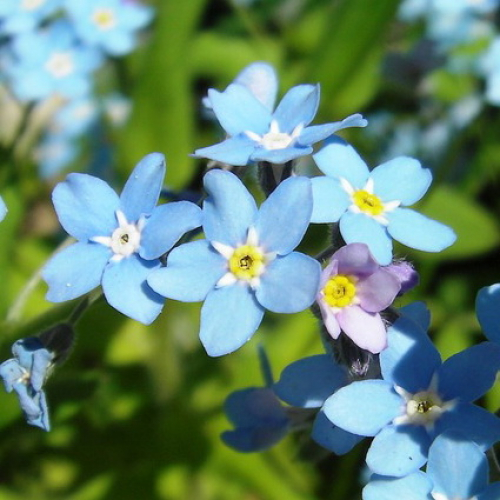Perennials Forget-me-not

Description
Characteristic Features of Forget-Me-Not
Forget-Me-Not (Myosotis) is a genus of annual and perennial herbaceous plants in the borage family Boraginaceae. In the wild, these plants with delicate flowers are quite common in Europe, Asia, America, Africa, and even Australia. They can be also found in almost every garden in the world. The habitats are mostly shady glades and wet areas near ponds, swamps, and rivers.
The Latin name of the plant comes from the Greek "myos" and "ous", which means "mouse's ear" because pubescent leaves resemble the ears of mice. However, in many languages, the name of this plant has another meaning, "Do not forget", and in the majority of nations Forget-Me-Not is a symbol of eternal memory, loyalty, love, and friendship. Fairytales and legends often have a common plot about a young man giving his bride a bouquet of forget-me-nots as a farewell present. It is also believed that a wreath of these flowers can bewitch a man. In the Russian-speaking community, other common names include feverish grass or gourd.
Forget-Me-Not has a branching stem 10-35 centimetres tall. The root system is shallow. Lanceolate leaves are arranged alternately. Small flowers can be snow-white, pale blue, or pink, with a yellow center. Flowers are borne in May and June. The fruit is a triangular ovate coccus. One gram contains up to 2,000 black seeds maturing in June and July and remaining viable for 2-3 years.
Forget-Me-Not looks great in any type of plantings, especially close to water. As a spring flowering plant, Forget-Me-Not is often accompanied by lilies, tulips, daffodils, viola, and erysimum. This delicate flower is also grown in containers. Forget-Me-Not has a good vase life and lasts for two weeks. Forget-Me-Not contains vitamins, macro- and micronutrients, tannins, and organic acids and also has medicinal uses.
The genus Myosotis is quite extensive and contains about 50 species. The most popular are the following:
Myosotis alpestris is a perennial up to 15 centimetres tall; it grows on rocks and has short rhizomes, pubescent leaves, and bright blue flowers. Its ornamental varieties combined under the name of Myosotis x hybrid are common in cultivation. These plants are grown as biennials and can be white, pink, or blue.
Myosotis palustris occurs near water, reaches a height of 30 centimetres, and has bright green lanceolate leaves and white, light blue, or blue flowers.
Wood Forget-Me-Not or Woodland Forget-Me-Not (Myosotis sylvatica) is a perennial plant grown as a biannual plant. It occurs in forests and other shady areas, is about 30 centimetres tall, and has oblong lanceolate leaves and typically blue flowers. There are also varieties with purple and dark blue flowers.
Myosotis dissitiflora occurs in the Alps, grows to 30 centimetres tall and has fairly large deep blue, light blue, white, or pink flowers.
Azores Forget-Me-Nots (Myosotis Azorica) grows to about 20 centimetres tall and has dark blue flowers.
The Secrects to Successfully Growing Forget-Me-Nots
Basically, Forget-Me-Nots prefer moist and shady places with fertile soil. They can grow well in full sun too but will bloom for a shorter time.
The basic care for Forget-Me-Nots includes regular watering, especially in dry weather, loosening the soil, feeding with complex fertilizers (mostly only in the year of planting), and winter sheltering with spruce branches or a layer of dry leaves (most of Forget-Me-Nots only withstand temperature drop down to -5 ° C).
Forget-Me-Not species are propagated by seed. Surface sow seeds in May-June on a seed bed or in the greenhouse. Plant out to a permanent location in late summer spacing about 20 centimetres apart. Forget-Me-Nots are self-sowers and can settle over a large area of the garden, thus becoming more of a weed than an ornamental plant.
For earlier flowering, sow the seeds indoors in October-November. The container must have a drainage hole. Fill the container with lightweight soil, moisten with a potassium permanganate solution, and surface sow the seeds. Cover the soil with paper and water on top. Prick out seedlings once they have their first set of true leaves, plant in small boxes spacing about 4 centimetres apart. Place the boxes in a cold greenhouse and move into a warm room in March. In mid-April, plant out to a permanent location in the garden. As a rule, Flowers are borne in May.
Varietal plants are propagated by cuttings. In May and June, cut apical shoots about 5 centimetres long, plant, and water. For some time, the cuttings need to be protected from direct sunlight. It should be noted that Forget-Me-Not are not fussy and can be transplanted even during flowering.
Potential Problems
Waterlogged soil can sometimes lead to mildew, as well as sulphuric rot and root rot. Ensure good drainage in the area, especially in the lowlands, and prevent overcrowding. Treat diseased plants with fungicides.
Forget-Me-Not can be attacked by cruciferous flea beetles, owl moths, aphids, and slugs. Control pests with insecticides.







 305
305







